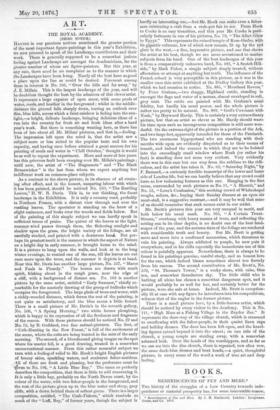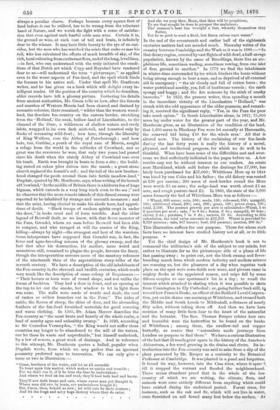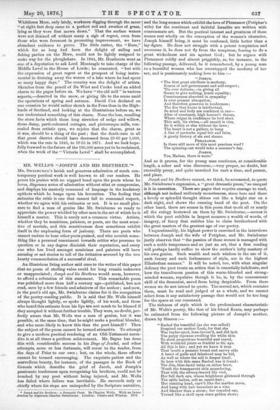BOOKS.
REMINISCENCES OF FEN AND MERE.* THE history of the struggles of a Low Country towards inde- pendence or material prosperity has, for some inscrutable reason,
• Reminiscences of Fen and Here. IV J. M. Heathcote. London Longtime, Green, and Co. 1876. always a peculiar charm. Perhaps because every square foot of land before it can be utilised, has to be wrung from the reluctant hand of Nature, and we watch the fight with a sense of satisfac- tion that even against such fearful odds man wins. Certain it is,
the ground so won, at such cost of toil and brain, is infinitely dear to the winner. It may have little beauty to the eye of an out- sider, but the man who has watched the mists that make or mar his toil, who has calculated the effects of much breadth of sky, of the rich, local colouring from exuberant flora, and of the long, level lines, —in fact, who can understand with the truly initiated the condi- tions of that Dutch art which Cupp and Ruysdael have rendered dear to us—will understand the term "picturesque," as applied even to the worst aspects of Fen-land, and the spell which binds
the fenman to his native soil. Under that spell Mr. Heathcote writes, and he has given us a book which will delight every in- telligent reader. Of the portion of the country which he describes, older records have left a gloomy picture. Gathering his details from ancient authorities, Mr. Green tells us how, after the forests and marshes of Western Mercia had been cleared and drained by
monastic colonies, there remained," wilder than the western wood- land, the desolate fen-country on the eastern border, stretching from the Holland,' the sunk, hollow-land of Lincolnshire, to the channel of the Ouse, a wilderness of shallow waters and reedy islets, wrapped in its own dark mist-veil, and tenanted only by
flocks of screaming wild-fowl ; how here, through the liberality of King Wulfere, rose the Abbey of Peterborough; and how
here, too, Guthlac, a youth of the royal race of Mercia, sought a refuge from the world in the solitudes of Crowland, and so great was the reverence he won, that only two years had passed since his death when the stately Abbey of Crowland rose over his tomb. Earth was brought in boats to form a site ; the build- ing rested on oaken piles driven into the marsh ; a great stone church replaced the hermit's cell ; and the toil of the new brother- hood changed the pools around them into fertile meadow-land." Dugdale, quoted by Mr. Heathcote, says, when writing of thehermit of Crowland," In the middle of Britain there is a hideous fen of huge bigness, which extends in a very long track even to the sea ;" and
he observes that the more remote islands of this dismal swamp were reported to- he ititabited by strange and uncouth monsters ; and
that the saint, having elected to make his abode here, had appari- tions of devils. "Black troops of unclean spirits crept in under the door," in looks cruel and of form terrible. And the older legend of Beowulf dealt, as we know, with that fierce monster of the Fens, Grendel, whom .no man before Beowulf had been able to conquer, and who ravaged at will the armies of the King, killing—always by night—the strongest and best of the warriors. Some interpreters have supposed that Grendel was, in fact, the fever and ague-breeding miasma of the gloomy swamp, and the fact that after his destruction, his mother, more weird and
monstrous still, remained to plague the people, favours the fancy, though the interpretation savours more of the sanatory reformer of the nineteenth than of the superstitious story-teller of the seventh century. We have a description of the old inhabitants of the Fen-country in the eleventh and twelfth centuries, which reads very much like the description of some colony of Esquimaux :—
" Their houses or huts were of round shape, and not unlike the forms of beehives. They bad a door in front, and an opening at
the top to let out the smoke, but window to let in light there was none. The walls were made of wattle and daub, the roof
of rushes or willow branches cut in the Fens." The hides of cattle, the fleeces of sheep, the skins of deer, and the abounding feathers of the fen-fowl furnished materials for good covering
• and warm clothing. In 1505, Dr. Adam Mercer describes the Fen-country as "the most brute and beastly of the whole realm, a• land of marshy ague and unhealthy swamp." In 1620, according to Sir Cornelius Vermuyden, "the King would not suffer these countries any longer to be abandoned to the will of the waters, nor let them lie waste and unprofitable," but himself undertook, by a law of sewers, a great work of drainage. And in reference to this attempt, Mr. Heathcote quotes a ballad, popular when Dugdale wrote, from which we may gather that an ignorant peasantry preferred ague to innovation. We can only give A verse or two in illustration :— " Come, brethren of the water, and let us all assemble
To treat upon this matter, which makes us quake and tremble ; For we shall rue it, if it be true the fens be undertaken ; And where we feed on fen and reed, they'll feed both beef and bacon.
They'll sow both beans and oats, where never man yet thought it, Where men did row in boats, ere undertakers bought it; But, Ceres, thou, behold us now ; let wild oats be their venture ; And let the frogs and miry bogs destroy where they do enter.
And eke we pray thee, Moon, that thou will be propitious, To see that nought be don@ to prosper the malicious ; Tho' summer's heat has wrought a feat, whereby themselves they flatter,
Yet be so good to send a flood, lest Essex calves want water."
In the end of the seventeenth and earlier half of the eighteenth centuries matters had not mended much. Macaulay writes of the country between Cambridge and the Wash as it was in 1689 :—"In that dreary region, covered by vast flights of wild-fowl, a half-savage population, known by the name of Breedlings, there live an am- phibious life, sometimes wading, sometimes rowing, from one islet of firm ground to another." In 1772 we find the inhabitants in winter-time surrounded by ice which hinders the boats without being strong enough to bear a man, and so deprived of all external aid in emergency ; "the air cloudy and full of rotten barn ; the water putrid and muddy, yea, full of loathsome vermin ; the earth spongy and boggy ; and the fire noisome by the stink of smoky hassocks." In 1852, the present writer, then spending a month in the immediate vicinity of the Lincolnshire "Holland," was struck with the odd appearance of the older peasants, and remark- ing it, received the significant reply, "Yes, in the Fens the poor take much opium." In South Lincolnshire alone, in 1817, 75,000 acres lay under water for the greater part of the year, and Mr. Heatheete gives, as an illustration of the condition of the land, that 1,600 acres in Blankeny Fen were let annually at Harecastle, the reserved bid being £10 for the whole area! All that is altered now. The history of the reclaiming of our fen-lands during the last forty years is really the history of a moral, physical, and intellectual progress, for which we do well to be thankful. What have been some of the difficulties met and over- come we find sufficiently indicated in the pages before M. A few results may not be without interest to our readers. An estate near Marshland, which sold before the drainage for £7,000, has lately been purchased for £57,000; Whittlesea Mere up to 1844 was hired by one Coles and his father ; the old fishery was rented at £30 per annum ; 200 acres of reed-border round the Mere were worth /5 an acre ; the sedge-land was worth about £1 an acre, and rough pasture-land £2. In 1860, the state of the 3,000 acres formerly the bed of Whittlesea Mere was as follows :— " Wheat, GOO acres; oats, 500; seeds, 150; cole-seed,150; mangold, 100; additional wheat, 200; oats, 200; grass, 100; green crops, 100; total, 2,100. The present growth per acre is calculated—Wheat, 5 to 6 quarters per acre ; oats, 7 to 8 do.; beans, 3 do.; mangold, 40 tons ; clover, 2 do.; potatoes, 7 to 8 do.; carrots, 10 do. According to this calculation, the total value amounts to £12,350. Wheat is provided for 3,329 persons ; oats, 307 horses; beef, 382 persons; mutton, 306 do."
This illustration suffices for our purpose. Those for whom such facts have no interest have studied history not at all, or to little purpose. •
Yet the chief design of Mr. Heathcote's book is not to commend the utilitarian's side of the subject to our minds, but rather to illustrate for us the picturesque side of a phase of life fast passing away ; to point out, not the black swamp and fever- breeding marsh from which modern industry and modern science are rescuing us, but the pleasures of a day when regattas took place on the spot were corn-fields now wave, and plovers came in mighty flocks at the appointed season,, and snipe fell by some fifteen couples to one sportsman's lot in a day ; to recall the interest which attached to skating when it was possible to skate from Connington to Ely Cathedral ; or, going further back still, tg record how Francis Drake, an officer of the Bedford Level Corpora- tion, put on his skates one morning at Whittlesea, and crossed both the Middle and South Levels to Mildenhall, a distance of nearly fifty miles, without taking them off. And then we have here mention of many little facts dear to the heart of the naturalist and the botanist. The Rev. Thomas Rooper relates how rare and beautiful were the butterflies to be found on the banks of Whittlesea ; among them, the swallow-tail and copper butterfly, so scarce that "naturalists made journeys from London on purpose to find them." We have a curious illustration of the fact that ill weeds grow apace in the history of the Anacharis Alsinastrum, a fen weed growing in the drains and rivers. Its in- troduction into the Fen-country was said to arise from a slip of the plant presented by Mr. Rooper as a curiosity to the Botanical Professor at Cambridge. It was planted in a pond and forgotten. It found its way, however, into the Cam river, where it spre-.1 till it stopped the current and flooded- the neighbourhood. There seems abundant proof that in the whole of the low country of which we are writing, the climate, flora, and animals were once entirely different from anything which could have existed during the undrained period. Forest trees, for instance, such as the oak and fir, which will not live in water, once flourished on soil found many feet below the surface. At
Whittlesea Mere, only lately, workmen digging through the moor "at eight feet deep came to a perfect soil and swathes of grass, lying as they were first mown down." That the surface waters were not drained off without many a sigh of regret, even from -those who were foremost in promoting improvement, we have abundant evidence to prove. The little cutter, the " Bure," which for so long had been the delight of sailing and fishing parties on the Mere, could not be lightly resigned to make way for the ploughshare. In 1844, Mr. Heathcote went as one of a deputation to ask Lord Monteagle to take charge of the Middle Level in the House of Lords ; he consented, "but with the expression of great regret at the prospect of being instru- mental in draining away the waters of a lake where he had spent so many happy days." The country was the delight of artists. Sketches from the pencil of Be Wint and Cooke lend an added charm to the pages before us. We have "the old mill" in various aspects,—deserted in the snow, or giving life to the scene amid the operations of spring and autumn. David Cox declared on one occasion he would rather sketch in the Fens than in the High- lands of Scotland, and looking at the illustrations before us, we can understand something of this charm. None the less, recalling the stern facts which those long stretches of sedge and willow, those damp, parti-coloured cottages, and picturesque mills, con- cealed from artistic eyes, we rejoice that the charm, great as it was, should be a thing of the past ; that the death-rate in all that great district should have decreased from 25.60 per 1,000, 'which was the rate in 1845, to 1955. in 1871. And we look hope- fully forward to the future of the 150,000 acres yet to be reclaimed, when the work of the "Victoria Level" shall be accomplished.
































 Previous page
Previous page